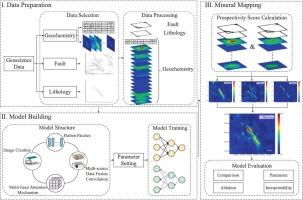多源地球科学数据的矿产远景映射:一种新的无监督深度学习方法
IF 3.6
2区 地球科学
Q1 GEOLOGY
引用次数: 0
摘要
矿产远景填图提供了潜在矿产资源分布的重要信息,有助于制定合理的资源开发战略,是矿产勘查的重要步骤。最近的方法主要集中在深度学习方法上,通过神经网络直接从相关数据中学习和提取信息,并输出识别矿产潜在区域的图。因此,本研究开发了一种基于视觉变压器的无监督深度学习的矿产远景图绘制方法。这种方法以无监督的方式进行训练,不需要标签和额外的人力。它以多源地球科学数据作为输入数据。多源数据融合卷积层对输入数据之间的特征信息进行融合。利用vision Transformer挖掘图像特征,为样品提供地球化学异常和地质约束信息。本文对新疆巴里坤黑山头地区铬铁矿床进行了预测,以作示范。从视觉和定量的角度进行了七个比较案例研究,都证明了该方法的优越性。通过多个不同角度的实验,进一步验证了该方法的可靠性。本文章由计算机程序翻译,如有差异,请以英文原文为准。

Mineral prospectivity mapping for multi-source geoscience data: A novel unsupervised deep learning method
Mineral prospectivity mapping provides important information on the distribution of potential mineral resources, which is helpful for formulating reasonable resource development strategies and is an important step in mineral exploration. Recent methods mainly focus on deep learning methods, which can directly learn and extract information from relevant data through neural networks and output map identifying potential areas of minerals. Therefore, this study has developed an unsupervised deep learning method for mineral prospectivity mapping based on vision Transformer. This method is trained in an unsupervised way, without the need for labels and additional manpower. It takes multi-source geoscience data as input data. Multi-source data fusion convolution layer fuses the feature information among the input data. The image characteristics are mined through vision Transformer to provide geochemical anomaly and geological constraint information for samples. This study predicts chromite deposits in the Heishantou area of Balikun, Xinjiang, China for demonstration. Seven comparative case studies were conducted from both visual and quantitative perspectives, all of which demonstrated the superiority of this method. The reliability of this method was further verified through multiple experiments from different perspectives.
求助全文
通过发布文献求助,成功后即可免费获取论文全文。
去求助
来源期刊

Ore Geology Reviews
地学-地质学
CiteScore
6.50
自引率
27.30%
发文量
546
审稿时长
22.9 weeks
期刊介绍:
Ore Geology Reviews aims to familiarize all earth scientists with recent advances in a number of interconnected disciplines related to the study of, and search for, ore deposits. The reviews range from brief to longer contributions, but the journal preferentially publishes manuscripts that fill the niche between the commonly shorter journal articles and the comprehensive book coverages, and thus has a special appeal to many authors and readers.
 求助内容:
求助内容: 应助结果提醒方式:
应助结果提醒方式:


